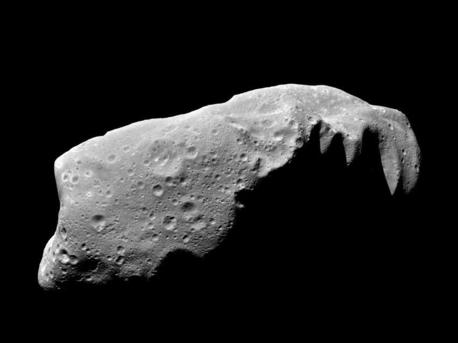Danger from Space
How can we prevent an asteroid impact?
 © NASA
|
The asteroid 243 Ida does not pose a threat to Earth right now
Alternatively, a missile could slow the NEO. The first experience with this strategy was in 2005 with the US spacecraft 'Deep Impact', which flew directly into a (harmless) comet. The goal of the mission was not, however, disaster control but to research the structure of comets.
There is no lack of ideas – but no viable solution.
It would also be an idea to detonate nuclear explosives near, on or underneath the surface of an NEO. Theoretically, a nuclear explosive could transfer a velocity impulse to the NEO that is over 100 000 times greater than would be possible with a rocket. Of course, an action of this sort would have to be carried out as far from the Earth as possible. A missile impact or nuclear explosion could however also cause the NEO to shatter or, if its stone structure is loose enough, it could absorb the impulse like a sandbag. In both cases, the collision course would remain unchanged.
Stationing a mirror system near the NEO, which concentrates the Sun's rays onto the surface of the NEO and thus vaporizes the surface material has also been considered. This would generate a thrust in the same way as a rocket motor. The thrust would be small but, with an operating time of several months, would be sufficient to allow the object to drift past the Earth in a free-flight phase of several years.
There is yet another emergency solution for NEOs that are smaller than around 3200 feet and which would not have global consequences: evacuating the impact area. This would have to take place quickly, as the exact point and time of impact can only be calculated with sufficient accuracy a few weeks before the impact event.
German Aerospace Center
Danger from Space
How can we prevent an asteroid impact?
 © NASA
|
The asteroid 243 Ida does not pose a threat to Earth right now
Alternatively, a missile could slow the NEO. The first experience with this strategy was in 2005 with the US spacecraft 'Deep Impact', which flew directly into a (harmless) comet. The goal of the mission was not, however, disaster control but to research the structure of comets.
There is no lack of ideas – but no viable solution.
It would also be an idea to detonate nuclear explosives near, on or underneath the surface of an NEO. Theoretically, a nuclear explosive could transfer a velocity impulse to the NEO that is over 100 000 times greater than would be possible with a rocket. Of course, an action of this sort would have to be carried out as far from the Earth as possible. A missile impact or nuclear explosion could however also cause the NEO to shatter or, if its stone structure is loose enough, it could absorb the impulse like a sandbag. In both cases, the collision course would remain unchanged.
Stationing a mirror system near the NEO, which concentrates the Sun's rays onto the surface of the NEO and thus vaporizes the surface material has also been considered. This would generate a thrust in the same way as a rocket motor. The thrust would be small but, with an operating time of several months, would be sufficient to allow the object to drift past the Earth in a free-flight phase of several years.
There is yet another emergency solution for NEOs that are smaller than around 3200 feet and which would not have global consequences: evacuating the impact area. This would have to take place quickly, as the exact point and time of impact can only be calculated with sufficient accuracy a few weeks before the impact event.
German Aerospace Center






